Laughing Anne ** (1953, Wendell Corey, Margaret Lockwood, Forrest Tucker, Ronald Shiner) – Classic Movie Review 10,361
Margaret Lockwood stars as the 1880s Parisian wicked lady nightclub singing star Laughing Anne.
Joseph Conrad’s triangle tug-of-love short story tale of amour and death in Java, Between the Tides, gets an overblown, stilted dramatic treatment in director Herbert Wilcox’s 1953 Technicolor British adventure film drama Laughing Anne.
Margaret Lockwood stars as the 1880s Parisian wicked lady nightclub singing star Laughing Anne, who becomes a singer in sordid bars in Java, where she falls foul of her abusive pugilist partner Jem Farrell (Forrest Tucker) when she is romanced by a seaman, Captain Davidson (Wendell Corey), and stows away on his boat.
Laughing Anne is a modestly budget movie, none too adroitly directed and lacking the feelings and tension that characterise Conrad’s work, as adapted here by Pamela Wilcox Bower, the stepdaughter of Anna Neagle. However, Max Greene [Mutz Greenbaum]’s Technicolor photography and Lockwood’s performance are attractive and the film’s saving graces.
Robert Harris plays Joseph Conrad, a Polish seaman in a café who tells the story.
Lockwood (dubbed by Lita Roza) performs a couple of rather pathetic songs: ‘All the World Is Mine on Sunday’ and ‘I’ve Fallen in Deep Water’.
Also in the cast are Ronald Shiner, Helen Shingler, Robert Harris, Danny Green, Harold Lang, Daphne Anderson, Jacques B Brunius, Edgar Norfolk, Gerard Lohan and Sean Lynch.
The film had poor reviews and box office and unfairly contributed further to the decline in Lockwood’s film career.
Herbert Wilcox had signed a co-production deal with Herbert Yates of Republic Pictures. Lockwood, who had signed a long-term contract with Wilcox, replaced his wife Anna Neagle. Tucker had been under contract to Republic for six years.
It is shot at Shepperton Studios, Shepperton, Surrey, England.
© Derek Winnert 2020 Classic Movie Review 10,361
Check out more reviews on http://derekwinnert.com



